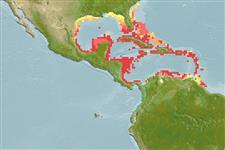Common names from other countries
Classification / Names / Names
Common names | Synonyms | Catalog of Fishes (gen., sp.) | ITIS | CoL | WoRMS
Environment: milieu / climate zone / depth range / distribution range
Ecology
Reef-associated; depth range 0 - 60 m (Ref. 847). Subtropical; 33°N - 8°N, 98°W - 58°W (Ref. 847)
Western Atlantic: Caribbean Sea.
Length at first maturity / Size / Weight / Age
Maturity: Lm ? range ? - ? cm
Short description
Morphology
Colonies are usually dome shaped and phaceloid, with widely spaced tubular corallites. Septa are evenly spaced in two alternating orders. Costae are well developed. Tentacles are extended at night and are of two sizes. Yellow brown to grey in color.
Maximum depth from Ref. 116012.
Life cycle and mating behavior
Maturity | Reproduction | Spawning | Eggs | Fecundity | Larvae
Members of the class Anthozoa are either gonochoric or hermaphroditic. Mature gametes are shed into the coelenteron and spawned through the mouth. Life cycle: The zygote develops into a planktonic planula larva. Metamorphosis begins with early morphogenesis of tentacles, septa and pharynx before larval settlement on the aboral end.
Cairns, S.D., D.R. Calder, A. Brinckmann-Voss, C.B. Castro, D.G. Fautin, P.R. Pugh, C.E. Mills, W.C. Jaap, M.N. Arai, S.H.D. Haddock and D.M. Opresko. 2003. (Ref. 1663)
IUCN Red List Status (Ref. 130435: Version 2024-1)
CITES status (Ref. 108899)
Not Evaluated
Human uses
| FishSource |
Tools
More information
Age/Size
Growth
Length-weight
Length-length
Morphology
Larvae
Abundance
Internet sources
Estimates based on models
Preferred temperature
(Ref.
115969): 25.4 - 28.1, mean 27.1 (based on 144 cells).
Price category
Unknown.
